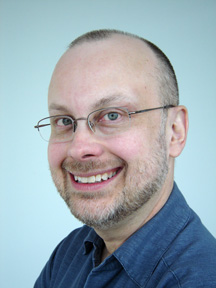
Interview: Robert J. Sawyer.
In this interview, Canadian science fiction author Robert J. Sawyer, winner of the Nebula, Hugo and John W. Campbell Memorial Awards, talks about his creative process, themes that fascinate him as author and reader. He also comments his participation in the TV series Flash Forward, inspired by his book of the same name, and his Neanderthal Parallax trilogy Neanderthal Parallax, whose first volume, Hominids, won the Hugo award in 2003.
Dear Mr. Sawyer, first, thank you for this interview.
Gilson Luis Da Cunha:
Dear Mr. Sawyer, first, thank you for this interview.
I got interested in your books after I read an article about Hominids, your first novel of the Neanderthal Parallax trilogy. Following your website, I learned that your original intention was to write something in the Planet of the Apes universe. However, you changed your mind. Your Neanderthal trilogy has a sharp social commentary, in my humble opinion, sharper than the novel of Pierre Boulle. To me, in a certain way, Ponter Boddit is a kind of Neanderthal “Ulysee Merou” or George Taylor (for the movie fans). Could you talk a little about that?
Robert J. Sawyer: You’re right; Tom Doherty, the publisher of Tor was hoping to get more into publishing media tie-ins. He and I were having dinner and he asked me if there was a tie-in license I’d like to work on. I said classic Planet of the Apes. Tom felt that was quite a depressing franchise, and it arguably is right up to the epilogue of the fifth and final classic film, Battle for the Planet of the Apes. And so I set out to create a universe of my own that was just as suited to social commentary. You’re also right that Pierre Boulle’s novel—which I do admire—is a fairly weak bit of social commentary; it’s mostly a satire of academic politics. Michael Wilson and Rod Serling, who wrote the screenplay for the first Planet of the Apes film, decided to aim at much more significant targets: race relations and the fear of nuclear war.
Now, yes, Boulle’s Merou and Wilson/Serling’s Taylor are indeed strangers in a strange land, but they’re people just like us—rather amiable in the case of Merou; a bitter, sarcastic misanthrope in the case of Taylor. My Neanderthal quantum physicist, Ponter Boddit, is a stranger, but the strange land isn’t the planet Soror (in Boulle) or Earth’s far future in (Wilson/Taylor) but Earth in the first decade of the twenty-first century; it’s our world. And Ponter is much more like Star Trek’s Spock in that regard: he’s the outsider commenting on us. I like to think I presaged the #MeToo movement by fifteen years, as well; the novel is very much about the shortcomings of many modern Homo sapiens males—Ponter is an example; a role model; an explication of what I think it means to be a real man: kind, compassionate, strong, forgiving, loving, intelligent, loyal, supportive. Although the trilogy found considerable support among the LGBTQ community for its portrayal of a fully bi-sexual Neanderthal world, it’s really a novel about Homo sapiens gender relations, and the need for men to do better.
Gilson Luis Da Cunha: You consider yourself a theme writer, someone who is driven by issues and can create characters and scenarios around these themes. When I was in college, a professor told me, “Always do research on the major issues.” I found almost exactly the same phrase in one of your books. As a reader, it is easy to identify the themes that motivate your writings: Cosmology, evolution of consciousness, ethics and morality are among your most valued themes. Now I ask you: how these issues have become part of your fictional universes? What authors influenced the reader Robert J. Sawyer?
Robert J. Sawyer: First and foremost, H.G. Wells, whom I encountered early in my teens. It was clear he was telling moral tales: about the evils of colonialism in The War of the Worlds; about the evils of class segregation in The Time Machine. I give him pride of place not because I encountered him first, or because he invented this mode—Mary Shelley actually did—but because he crystallized it for me.
Next, Gene Roddenberry and his writers, and the best episodes of the original Star Trek. You know, the third season of Star Trek takes a beating in fannish circles, but it in fact was a course correction; Roddenberry saw his creation going off course with comedic episodes—“The Trouble with Tribbles,” “I, Mudd,” and “A Piece of the Action”—and Fred Frieberger, the third season producer, brought it back to a thematic show: look at “The Empath,” which is a riff on Stanley Milgram’s obedience-to-authority experiments and the effect they have on the experimenters; look at “Let That Be Your Last Battlefield,” which is precisely as unsubtle as the message needed to be for an episode produced in the year Martin Luther King was assassinated.
After that, yes, Rod Serling and Michael Wilson for Planet of the Apes, plus the brilliant Paul Dehn, who wrote or co-wrote all the sequels. Serling’s The Twilight Zone often struck me as heavy-handed and simplistic; his best work was in his draft of Apes (although all the memorable lines are Wilson’s).
There wasn’t as much thematic stuff in the SF literature I read in my teenage years: Asimov, Clarke, Niven—you can struggle to superimpose a theme, but mostly they’re just clever invention. But Frederik Pohl changed my life with Gateway, the best exploration of the theme of guilt I’ve ever seen.
Gilson Luis Da Cunha: Still talking about Neanderthal Parallax, I just read the second book of the trilogy and, like the first, I concluded the reading, eager to read the next book. I am interested in human evolution and paleoanthropology, and your book present us the Barast society with an extremely fluid plot, without compromising the pace of the narrative. It is not easy to do it when building an universe. How was your creative process in this story?
Robert J. Sawyer: I read everything I could find about Neanderthals—technical literature and popular accounts—and I went to meetings of The Paleoanthropology Society, getting to speak directly to just about every significant Neanderthal researcher in the world, including Erik Trinkaus and Milford Wolpoff. Then I made a rule: everything I settled on for my Neanderthal culture would have to be supported by the scientific literature. I didn’t necessarily pick the most likely interpretation, but the most interesting ones. Most significantly, the notion that male and female Neanderthals lived largely separate lives comes form an interpretation by Lewis Binford of the site at Combe Grenal. And there’s lots of solid evidence that Neanderthals had no religious beliefs, and only very scanty, wishful-thinking stuff that suggests that they did.
Gilson Luis Da Cunha: Unfortunately, you have a single book released in Brazil, FlashForward (Record Publishing, Brazil). I had some difficulty to find it, even in the largest bookshop franchises, which suggests to me that the edition sold out quickly. I loved the television adaptation and I was sorry by the cancellation of the series. There were incredible concepts that were just beginning to be explored. Could you talk a little about your participation in the television adaptation?
Robert J. Sawyer: I was consultant on every episode, wrote one of the episodes, and had a cameo in the pilot. I had an absolutely fabulous experience: they treated me well in every way, and I made friends I will value for the rest of my life.
Gilson Luis Da Cunha: You are a huge fan of Planet of the Apes, as well as classic series of science fiction TV, like Star Trek and The Six Million Dollar Man. This background appears in some of your plots. I loved the references to The Six Million Dollar Man in Humans. What do you think of using pop culture elements in today’s science fiction books?
Robert J. Sawyer: My editor at Tor, the late David G. Hartwell, and I used to argue about this. He was against it, but I’m in favor of it, for two reasons. First, it helps ground what I’m writing in reality. It’s crazy to think that a story takes place in a world where Star Trek and Planet of the Apes, now both more than fifty years old, The Six Million Dollar Man, now 45 years old, don’t exist and never did; that would be some alternate reality, not our universe. And, second, there’s a meta-fictional aspect: science fiction, as a genre, is considered pop culture, and sometimes dismissed because of that, but more people in the world remember and have been influenced by Star Trek than any other 1960s TV show ever. Science fiction—when it’s good and thoughtful—endures.
Gilson Luis Da Cunha: You recently launched Quantum Night. The implications of quantum physics are recurring themes in your work. In fact, this is one of the most fascinating branches of physics. How did you became interested in this subject as part of your stories?
Robert J. Sawyer: I read an enormous amount of nonfiction in all fields of science, just to keep up, and, of course, quantum physics has, for the last century, been he most interesting branch of physics. Also, quantum physics ties into—and questions our assumptions about—the very nature of reality. It’s as much a philosophical topic as a scientific one when you think about it that way, and I’ve always thought of myself really as a philosophical fiction writer—not sci-fi, but phi-fi.
Gilson Luis Da Cunha: I recently read a comment of you about the detection by astrophysicists of gravitational waves, which Einstein thought were impossible to prove empirically. Have You ever considered include this scientific fact in a future novel?
Robert J. Sawyer: Sure—and so has every hard science fiction writer, I’m sure. But there’s no point jumping on a bandwagon; we knew gravity waves almost certainly existed, after all, long before this, and my very first sale—short-story “Motive,” which I wrote in 1979, was about an alien who could detect gravitational waves. I’m much more interested in writing about things that are plausible but aren’t yet actually proven than simply incorporating the latest discovery for the sake of somehow appearing current.
Gilson Luis Da Cunha:
Thank you very much for this interview.
